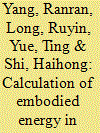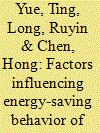|
|
|
Sort Order |
|
|
|
Items / Page
|
|
|
|
|
|
|
| Srl | Item |
| 1 |
ID:
132602


|
|
|
|
|
| Publication |
2014.
|
| Summary/Abstract |
In order to find efficient trade measures to reduce China×s energy consumption and to provide theoretical support for the climate talks between China and America, we investigate the impact of Sino-USA trade on energy consumption from the perspective of embodied energy. An Environmental Input-Output Life Cycle Assessment (EIO-LCA) model was established to calculate the total energy consumption coefficient, the direct consumption coefficient and the complete consumption coefficient of the sectors of the national economies of China and America. After taking into consideration the data of every sector of the national economy in Sino-USA trade, energy embodied in the import and export trade between China and America was calculated to verify the real energy flows in Sino-USA trade. The research results suggest the following: China is the net exporter of embodied energy in Sino-USA trade, and coal, crude oil and natural gas are the major components. In 1997-2011, the net exports of China×s embodied energy totaled 1523,082,200 t of standard coal, the amount of China×s energy consumption increased by 895,527,900 t of standard coal, and America×s energy consumption decreased by 11,871,200 t of standard coal as a result of Sino-USA trade. On this basis, corresponding policies and recommendations are proposed.
|
|
|
|
|
|
|
|
|
|
|
|
|
|
|
|
| 2 |
ID:
125762


|
|
|
|
|
| Publication |
2013.
|
| Summary/Abstract |
In this research, the willingness of households to adopt different energy-saving behavior has been analyzed, and factors influencing energy-saving behavior in Jiangsu Province, China, have been examined. The study builds on a broad and practical conceptual framework that embraces three types of energy-saving behavior and four dimensions of influencing factors, including socio-demographics, energy-saving awareness, behavioral ability, and situational factors. The empirical results are based on an Internet survey that was sent out to 638 households. The results indicate that socio-demographic characteristics, including age, gender, income level, household structure, and educational background, are all important factors influencing energy-saving behavior. At present, respondents adopt the usage-reduction type of behavior more often than the other two types, which require a greater capacity to pay for energy-efficient products and a higher level of energy-saving awareness. Situational factors have significant positive moderating effects when the variables of behavioral ability and energy-saving awareness act on energy-saving behavior. In addition, the results also show that spatial differences exist among the three regions of Jiangsu Province. Finally, some implications of these results for the design of future incentive policies and measures to encourage energy-saving behavior are presented.
|
|
|
|
|
|
|
|
|
|
|
|
|
|
|
|
|
|
|
|
|